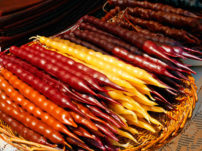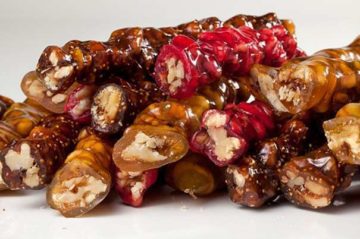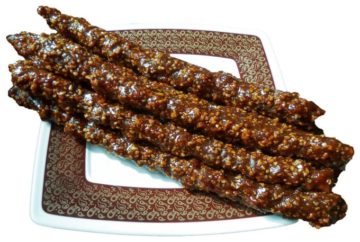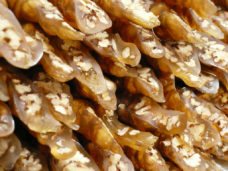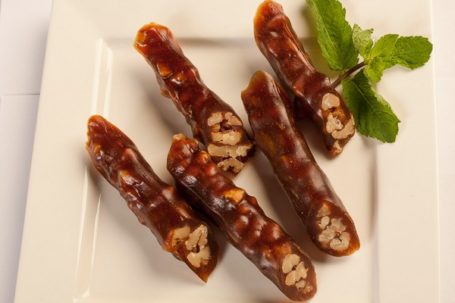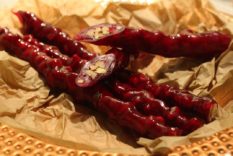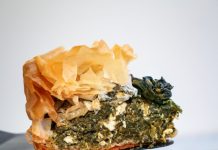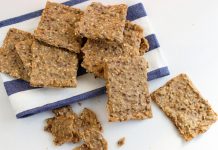“Churchkhela what is it?” - an involuntary question arises in my head. Everyone who has ever been to the Caucasus, the Krasnodar Territory or the Black Sea must have heard this mysterious word. Local merchants now and then offer to try an unknown dish. What is it, and is it possible to cook churchkhel at home?
Material Content:
What is churchkhela?
Churchkhela - an oriental sweet, popular among the Caucasian peoples, is also common in Armenia, Greece, Turkey. In each country, this dish is assigned its name, but its essence does not change from this.

Churchkhela is a nut thread covered with condensed grape juice, sweet in taste, and has high nutritional value. Since the individual components are very useful in themselves and contain a large amount of substances necessary for the body, the whole dessert is full of vitamins, minerals, natural sugars, unsaturated fatty acids and vegetable protein.
The question of the origin of sweets is controversial. Churchkhela is considered a Georgian national delicacy. However, there is evidence that at first a very similar dish appeared in Armenia. The prototype was called “sprat” and was a thick grape jelly mixed with nuts. The filling was not strung on a thread, but simply added to caramel. The dessert was not allowed to dry; it was eaten immediately after cooking.
But in 2011, Georgia registered its rights to churchkhela. And now the dish is considered truly Georgian. Despite this, it is prepared in many other countries.
Some people ask themselves: “how is it right: juchela or churchkhela”? The answer is obvious. The Georgian word is pronounced “churchkhela”, and there are no other options.
Main ingredients
Churchkhela is mainly made from walnuts and grape juice.
However, the use of other components is not prohibited. The filling can be hazelnuts, almonds, cashews or pecans, candied fruits, raisins, prunes, dried apricots, dried cherries, etc. Sweetness is also made on the basis of a mixture of different varieties of nuts and a mix of nuts and dried fruits.
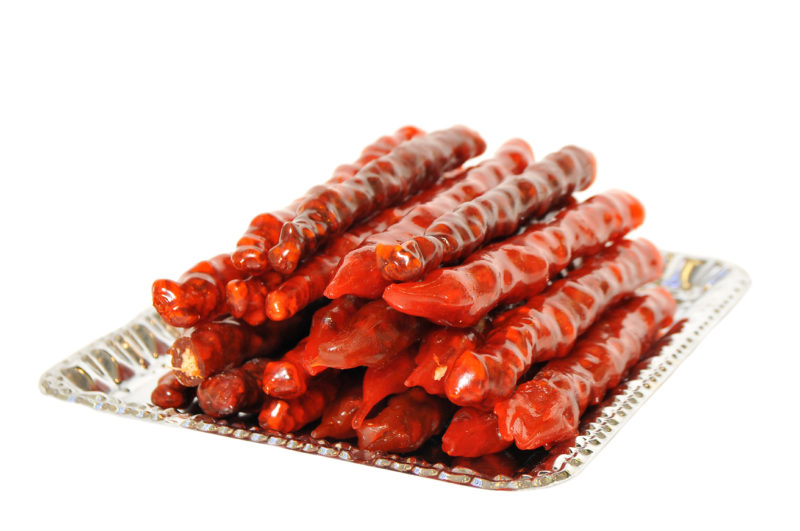
Grape juice is thickened with cornmeal, but this rule is not immutable. Instead, you can use ordinary wheat flour. This does not affect the taste and usefulness of the dessert.
If desired, even grape juice can be replaced with pomegranate, apple, peach, plum, cherry and any other. There are no strict requirements. Each component brings something of its own, changing the taste and appearance of the dessert.
From grape juice, a delicacy of red or chocolate color is obtained. Churchkhela apple becomes amber. Pomegranate juice is very valuable in itself. He is rarely sent for the manufacture of churchkhela, since because of it the cost of the product is greatly increased. At home, you can experiment with different tastes and make oriental sweetness from those fruits that are at hand.
Churchkhela contraindications
In any article dealing with this delicacy, the “churchkhela benefit and harm” section takes up very little space. Oriental sweetness made in the traditional way contains only natural ingredients. Therefore, for a healthy person, it is not dangerous, but very useful. However, people with some problems should beware of its excessive use.
So, because of the high sugar content, churchkhela becomes very high in calories. There are 400-500 energy units per 100 grams of product. Those who want to lose weight should not overdo it in eating. Overweight people should completely abandon the use of churchkhela.
Due to the same sugars, it is not suitable for diabetics suffering from a serious stage of the disease. Churchkhel has a lot of complex and simple carbohydrates that quickly enter the bloodstream.
This dessert is rich in minerals, and their excess burdens the kidneys. Therefore, churchkhela should be limited to people with relevant problems, using it sparingly.
How to cook churchkhela at home
Learn the recipes. Watch a video on how to make churchkhela, and then proceed to do it yourself. This process is not laborious, but long. Be patient, let the dessert ripen, and only then take samples.
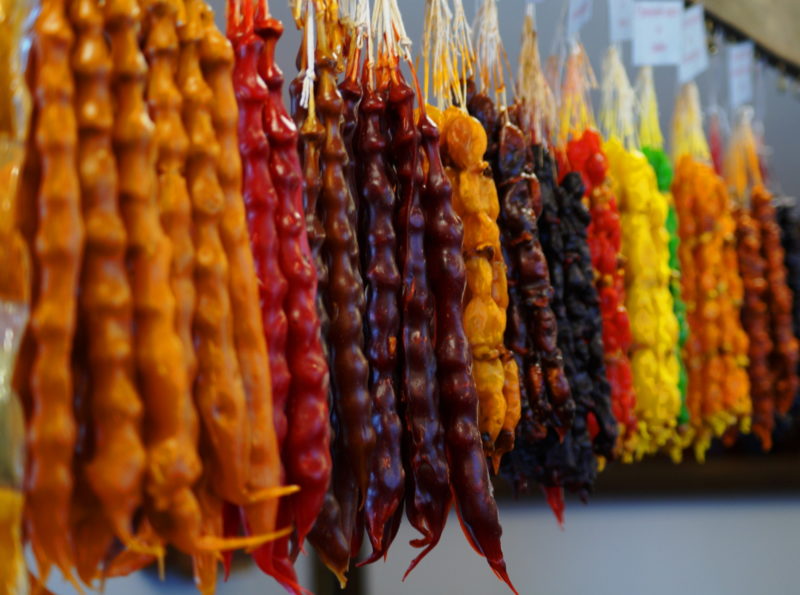
Find a place in the kitchen where you hang nut threads. For some time, juice will flow from churchkhela. Think in advance that under it should be laid so that you can easily remove the puddles of syrup.
Prepare a dry container in which to fold the blanks. Churchkhela will need to be removed to a dark place where it will ripen in order to acquire a harmonious characteristic taste.
Churchkhela classic recipe
The classic recipe involves walnuts. Raw and maximally fresh fruits are used. We determine their state by eye: we need light, uniform, straw-colored, without darkening and bitterness.
You can supplement them with cashews, hazelnuts, pumpkin seeds. Raisins, dried apricots and prunes also will not hurt.
Walnuts should be halved. The larger the particles of the filling, the more elegant the churchkhela will look.
Prepare a thick cotton thread and a thick needle. We will also need a thimble, without it it will be quite difficult to pierce nuts.
String the stuffing. We make a sausage 15-20 cm long. We leave the end of the rope free. Subsequently, we will hang churchkhela so that it dries, on some basis. And we will attach to the base with the free end of the thread.
We cook pelamushi. This is a thick grape syrup that envelops skewered nuts.
For 350 grams of filling, 2 liters of red or white grape juice are consumed. It is better to take fresh, in extreme cases, buy at the store. You can work hard and make it yourself. Juice is made by pressing berries in a juicer. Or grind the grapes with a blender and squeeze the resulting mass through cheesecloth or sieve.
Pour one half into the pan, set the other aside.Boil the part in the pan and continue cooking for 15 minutes.
In the second half of the juice, dissolve a glass of flour. It must be gradually poured and stirred so that no lumps are formed. Add this mixture to boiling juice. We will cook until the mass decreases in volume by a quarter. In general, it should thicken and consistency should become like a viscous caramel.
Take turns lowering the sausages in grape jelly. Lightly adjust them with a wooden spatula so that they are saturated with juice on all sides. We hang the finished knit for half an hour to dry.
Repeat the procedure. We will make it many times until the nuts are covered with a crust of grape juice 1-1.5 cm thick. Then we hang the bundle for drying and leave it for two weeks.
Outside, the juice hardens and turns into a smooth shiny glaze, inside the mass will remain soft. In this state, churchkhela is ready for use, but you can be patient and let it mature.
To do this, it should be wrapped in parchment or a waffle towel, put in a container and sent to a dark, dry place for 2-3 months. Churchkhela, like a good wine, in the process of ripening reveals its best properties: it becomes harder, enriched with aromatic substances. Its surface is covered with a thin sugar coating.
Juice in mature churchkhela becomes homogeneous, in consistency similar to dense jelly. Dessert breaks off nicely, chews easily, does not knit and does not stick to teeth.
Finished sweets are stored for a long time under certain conditions.
How to store churchkhela? It should be a dark, well-ventilated room with normal humidity.
Churchkhela with red nuts
Roasted walnuts become brittle, it is almost impossible to string them. Therefore, for such a recipe it is better to take red hot hazelnuts.
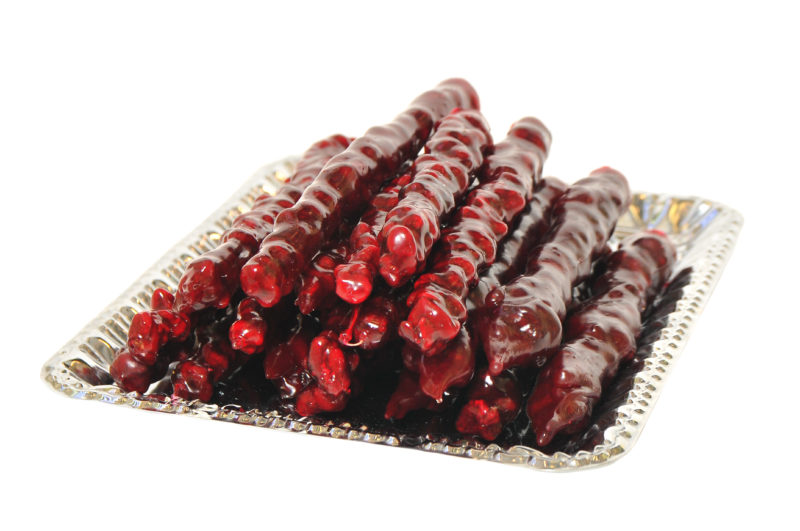
You can buy the nuts ready or fry them yourself. Place the hazelnuts in a dry, hot pan. Fry over medium heat, stirring constantly until golden brown and a characteristic odor appears.
If the nuts become too dry, they cannot be strung together. They will crack. Therefore, before further cooking, it is advisable to soak them in warm water. Swollen nuts will no longer crumble.
For churchkhela you will need:
- 200 grams of hazelnuts;
- 1 liter of grape juice;
- 130 grams of flour (about 2/3 cup).
Divide the juice in half. Boil one part and boil for 15 minutes. In another part, we dissolve the flour and add this whole mixture to boiled juice. Boil another 10-15 minutes, turn off the heat.
We make beads from nuts, stringing them on a strong thread. From the bottom we are knotted. We form a loop from above, for which we will hang the sweetness.
Three times with a break of 30 seconds, we dip the beads in turn into the grape jelly. Hanging churchkhela. Let the excess juice drain and dry the workpiece a little. Dip into the syrup again and repeat until it reaches the desired thickness.
We hang churchkhela in a dark place. Sweetness will dry out in one to two weeks. After that, it is ready for use, but for better fixing it can be sent for maturation.
Spicy churchkhela
The basis of spicy churchkhela is still the same grape juice. We take any nuts, raw or red-hot. Their total weight should be 300-350 grams. Also needed as in the classic recipe 2 liters of grape juice. Sweet lovers can add 1-2 tablespoons of sugar to it.
The taste becomes spicy due to the presence of cinnamon and cloves. Take a third of a teaspoon of the first seasoning and 4 pods of the second.
Divide the grape juice into two parts. We put half on fire. Boil in slow heat for 15 minutes. In another container, mix cold juice with a glass of wheat or corn flour.
We add the flour mixture to a boiling brew. Add sugar and seasonings to the general pot. Keep on the fire for just another 10 minutes and proceed to the main action.
We dip the threads with nuts into the prepared mass. We give them a little dry, and do it again. We put churchkhela to dry. We are waiting for 1-2 weeks when it hardens.
Armenian churchkhela
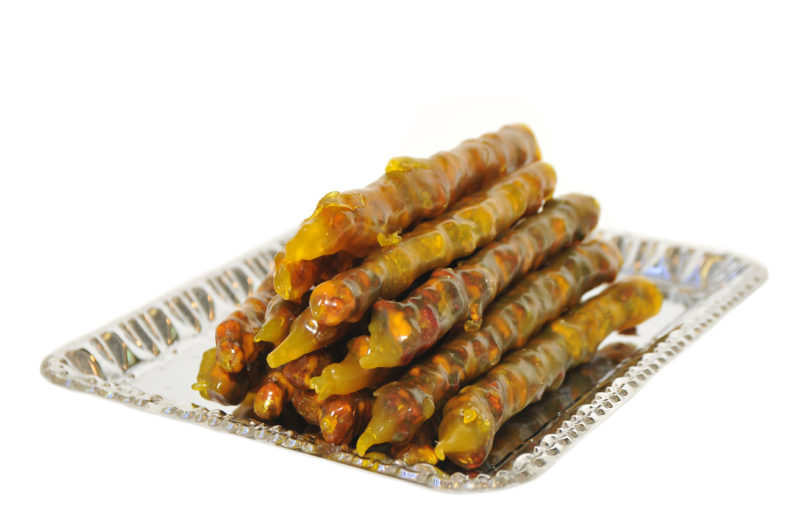
For Armenian churchkhela we take a liter of apple juice. We will thicken it with corn flour (120 grams). We do everything as usual. We’ll put one part on fire. In another, we dilute the thickener. Combine both parts in a saucepan, add vanilla or cinnamon to taste. Boil the syrup to the consistency of a thick jelly.
For the filling, combine your favorite nuts, prunes, dried cherries and grapes. Gently lower the double thread. Dip all the charm in boiled juice.
We will hang sweet threads in a secluded corner, after having spread the parchment paper under them. We will dry in the absence of direct sunlight for about two weeks. Do not forget that the room must be well ventilated.
Churchkhela plum recipe
We will cook churchkhela with natural plum juice. We take 2.5 kg of ripe fruits. Free them from the bones and peel. Scroll the pulp in a meat grinder or grind with a blender. Press through a sieve and get juice.

Mix it with 120 grams of flour or potato starch. Add 2 tablespoons of sugar. Put on fire. Boil a little. Let the mixture boil and thicken to the desired consistency.
Pre-prepare the filling of nuts, candied fruits and dried fruits. Make beautiful tight beads. Roll them several times in plum caramel. Hang to dry. We’ll check availability in two weeks. If the surface of churchkhela is no longer sticky, oriental sweetness can be removed from the crossbar and used for your own pleasure.
Now you have learned how to do churchkhela at home. This is completely uncomplicated. The main thing is to be patient, to observe all the conditions of preparation and not to eat a treat until the moment it is ready.




